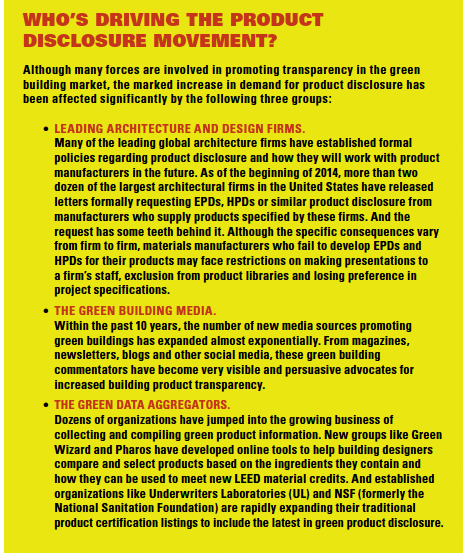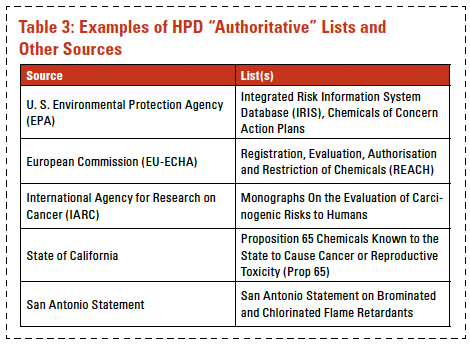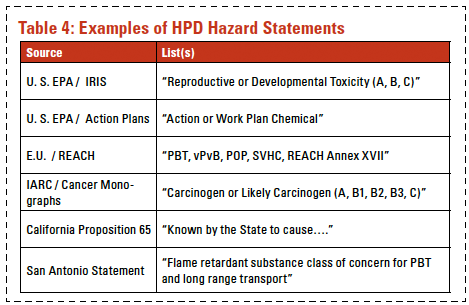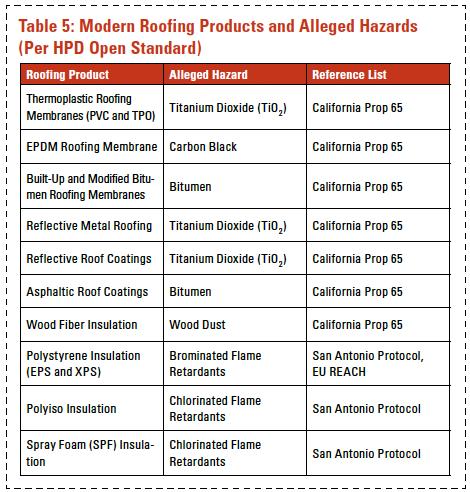Disclosure: The Newest Dimension in Green Building

Health Product Declarations (HPDs)
Compared to the EPDs, the HPD is a brash newcomer, with the first HPD standard formally published just a few years ago. As a result, the most significant difference between EPDs and HPDs involves the degree of rigor and standardization in their underlying processes. Where EPDs rely on scientific method and quantifiable measurement, HPDs rely less on certainty and more on precaution. In fact, one of the founding values of the HPD is the precautionary principle, which advocates for the restriction or elimination of products if there is any concern about their safety. In addition, the measurements used in HPDs may be considered much less quantifiable than EPD metrics. Rather than providing a measurable effect on health impact, the HPD simply identifies the presence or absence of specific chemicals. As with EPDs, there are many definitions of HPDs; but in light of our previous definition of the EPD, the HPD may best be described as a tool that discloses product ingredients and known/ suspected health hazards associated with these ingredients, based on a variety of reference sources.
Product Ingredients. Without a doubt the most critical feature of the HPD is the full disclosure of all ingredients in a building product. Because many building materials, especially materials other than liquids such as coatings or adhesives, are not specifically subject to current Material Safety Data Sheet (MSDS) regulations, manufacturers are under no obligation to disclose the specific ingredients in their products. And even though many building materials manufacturers do in fact voluntarily provide MSDSs for their products, procedures regarding the disclosure of important health impacts that may be relevant to the building designer are not well established. As a result, the HPD offers a more standardized approach to the disclosure of ingredients. Current HPD standards also allow for the use of proprietary ingredients without disclosing the specific chemical or mixture as long as the health hazards are clearly identified and disclosed.
Reference Sources. After a product’s chemical ingredients have been identified in an HPD, these chemicals must be screened against a variety of reference lists which identify any health hazards known or suspected to be associated with the ingredients. Frequently, these lists are referred to as being “authoritative” because many of the lists have been established by leading national and global bodies based on the best science available. However, these lists may vary significantly in terms of their recognition and scope. Some examples of current HPD “authoritative” lists are shown in Table 3.
It should be noted that Table 3 provides only a partial listing of current HPD reference sources. The full listing in the current HPD Open Standard includes more than one dozen compilers and more than two dozen specific lists.

Known/Suspected Hazard. For any chemical flagged by one or more of these lists, specific hazard warnings are provided by the list compiler. Similar to hazard warnings on the MSDS, these warnings identify hazards related to specific health concerns, such as cancer, reproductive toxicity, developmental toxicity, etc. Table 4 provides a selected listing of typical hazard language associated with a selection of current HPD reference lists.
After screening each chemical ingredient against the hazard references, all known and suspected hazards as identified by these lists must then be reported as part of the HPD.

HPDs in Codes and Standards
HPDs are included as part of the newest LEED Green Building Rating System (LEED v4) under Option 1 of Credit MRc4 (“Building Product Disclosure and Optimization: Material Ingredients”). In this option, LEED credit may be awarded for projects that incorporate at least 20 products covered by HPDs or similar disclosures. Like EPDs, HPDs also may soon become part of other well-known green building codes and standards. Many observers anticipate that one or more proposals about HPDs will be submitted as part of the 2014 code hearings for the 2015 version of International Green Construction Code (IgCC).
Benefits and Limitations of HPDs
Benefits. Undoubtedly the biggest benefit offered by the HPD is its low cost to produce. In contrast to the exhaustive science required to develop an EPD, the time and effort to develop an HPD is much less demanding. Because product manufacturers already possess a reasonable understanding of their ingredients and have access to data from their raw material suppliers, the effort required to produce an HPD differs little from the work needed to produce the common Material Safety Data Sheet (MSDS). Based on the experiences of several manufacturers who participated in a pilot trial of HPDs in 2012, completing the first HPD may take a day or two. And after the first HPD is finished, it is likely that additional HPDs can be completed in less than a day. Because the time and resources required to complete an HPD are relatively small, the cost per HPD may be calculated in the hundreds of dollars rather than the tens of thousands of dollars required to prepare and publish an EPD.
Along with low cost, HPDs also offer an innate simplicity not available with EPDs. Instead of reviewing dozens of complex measures involved in quantifying a broad range of environmental impacts, the sole function of an HPD is to identify the presence or absence of known or suspected health hazards. As a consequence, HPDs may be more suitable for the non-scientist to review and use. As stated by Russell Perry, FAIA, of architectural firm SmithGroupJJR: “We do not need everyone to be an industrial hygienist in order for (HPDs) to be a valuable contribution to the building industry. We are not scientists in all of this, and we don’t need to be. We’re not making risks assessments. We’re simply saying we have to get what these products consist of out into the world.” (“Taking a Stance on Transparency,” ECOBUILDING Pulse, Oct. 4, 2013.)Limitations. The most obvious limitation of the HPD relates to its infancy as a standard. Unlike widely recognized standard processes such as ASTM, ANSI and ISO, the HPD protocol was developed using an “open standard” approach advanced by a coalition of health-oriented building advocates. This protocol, called the HPD Open Standard, was developed primarily by representatives of the founding sponsors with little or no formal public participation. In addition, material manufacturers did not directly participate in the development of the standard, but rather were relegated to a pilot trial of standard that was for the most part in its completed form. As a result, many of the guiding principles of standard consensus processes — open participation, balanced stakeholders, consideration of all viewpoints and the availability of an appeals process — were not included in the development of the current HPD protocol.
Perhaps as a result of the limited consensus process involved, the current HPD Open Standard includes a number of weaknesses and discrepancies. First, the current HPD standard fails to clarify if it is necessary to report chemical ingredients that are effectively transformed or consumed during manufacturer. As an example, the production of polyurethane products such as foam insulations, coatings and sealants requires the use of MDI, a chemical considered hazardous when directly exposed to humans. But for polyurethane products produced in the confines of a factory (such as rigid polyiso foam insulation), all of the MDI is consumed and transformed into a resultant cellular foam that itself contains no MDI. In a similar manner, several red lists include styrene as a chemical health hazard, but polystyrene building materials (the typical EPS and XPS foams used for building sheathing and insulation) do not directly contain styrene.
The lack of clarification in HPDs also is challenging in regard to chemical mixtures. Many popular roof and wall products rely on the use of materials that may be considered hazardous when airborne, but in almost all cases these materials are firmly encapsulated into a larger chemical matrix that poses little or no risk of release into the building environment. Examples of such materials include titanium dioxide (TiO2), which is a key component in almost all “cool” roofing products, and carbon black, which is a key ingredient in rubber roofing membranes and sealing gaskets. Some hazard lists such as California Proposition 65 even include wood dust as a hazard. Does that mean we should identify all wood products to be hazardous?
The lack of clarification regarding ingredients is further compounded by the broad and disparate collection of “authoritative” lists used to identify hazard. Some of these lists, such as the EU REACH protocol, are widely acclaimed and accepted throughout the world. In most cases, this acceptance is due to the high levels of science and consensus used to develop the list. Others, such as California Proposition 65, are more regional in scope and in many cases are simply derivative collections of hazards identified by other lists. Some of the lists, like the U.S. EPA Work Plan List, do not actually identify a known hazard but rather are used to identify materials that are being subjected to further government review. Finally, some of the lists, such as the San Antonio Statement, are not actually lists but rather a public statement of opinion by a group of concerned individuals. But regardless of the level of recognition each “authoritative” list has achieved, the hazards they identify must be treated as equal threats within the HPD reporting protocol. As a result, many products that contain absolutely no hazardous chemicals as identified by the world’s most recognized authorities still must be identified as hazardous if they contain any ingredient included in the dozens of less-recognized lists and sources covered within the current HPD framework.
Taken as a whole, the potential for product exclusion within the current HPD Open Standard protocol may be significant for many segments of the building material industry. As an example, the HPD for the majority of commercial roofing products will likely include the disclosure of at least one ingredient alleged to be hazardous by one or more of the “authoritative” lists. Table 5 provides a listing of these roofing products, the alleged hazards they may contain and the reference list from which the alleged hazard is identified.

This table, which includes every major commercial roofing material available in today’s market, may help illustrate one more concern about the current HPD Open Standard. When I have raised examples of products in this table to several leading green building advocates, their response has been, “Well, I’m sure the HPD Open Standard doesn’t intend to flag all these products as hazardous. After all, many of these ingredients, like TiO2 or wood dust or carbon black, in roofing materials will likely never affect building occupants.” This argument may be valid, but how will manufacturers respond in their published HPDs? As an example, if a building product manufacturer produces a product containing even a theoretical portion of any California Proposition 65 listed ingredient (and there are more than 400 of them!) and fails to list the ingredient on their product labels and literature, they could be in legal jeopardy for failing to comply with the specific reporting requirements of Prop 65. And past experience from California suggests that there are plenty of law firms just looking for the opportunity to initiate a Prop 65 lawsuit. As a result, I doubt that any product manufacturer will fail to report these ingredients and their alleged hazards in the HPDs they publish.
And how will building designers respond to HPDs that contain hazard warnings about cool roof coatings, wood, carbon black and the like? They will now be in possession of information stating the products they plan to specify contain ingredients potentially hazardous to the health of the clients. As a result, the inclusion of so many chemicals that may only be remotely connected to actual occupant health hazard could easily damage the credibility of the HPD as an objective and effective tool. In simpler terms, if the HPD flags every building product as hazardous, the relevancy and usefulness of the tool will be lost.
The final and perhaps most critical limitation of the current HPD Open Standard is the lack of risk assessment to accompany the current hazard identification. Stated simply, many materials may be considered potentially hazardous, but a useful understanding of the actual hazard requires an assessment of the risks involved. Some of the key elements of risk assessment currently lacking in the HPD Open Standard include:
- Threshold Level. At what level does exposure actually produce adverse health effects? Using toxicological science and experimental evidence, a maximum threshold level can be established, usually with a significant margin of safety (MOS) typically in the thousands.
- Exposure Path. How can any particular hazardous ingredient directly affect building occupants? In the case of many roof and wall products, especially exterior products or materials such as insulation that are enclosed within walls and roofs, the potential for exposure will likely be very low.
Unfortunately, the current HPD protocol provides little or no information to that may help a building owner or designer make decisions based on the actual risk posed by a building product.
Potential Alternatives to HPDs
As the building industry starts to digest the nuances of the new HPD Open Standard, the need for important changes to the standard are becoming apparent. Definitions regarding ingredients need to be broadened to accommodate a wide variety of real-world situations. And the “authoritative” nature of some of the reference lists needs to be examined. Finally, the concept of hazard needs to be expanded to include risk, especially if HPDs are to move up to the level of science and rigor established by EPDs.
Although many new initiatives to advance product health disclosure will focus on improving the current HPD process, other initiatives will focus on the development of better alternatives. Currently, two potential alternatives are available that may help address some or all of the limitations of HPDs. These alternatives include the new Safety Data Sheet (SDS) and the Product Transparency Declaration (PTD).
Safety Data Sheet (SDS). Even before the HPD Open Standard was developed, the world already was in the middle of a significant transformation regarding the reporting of product hazards. This transformation involved the harmonization of all product safety reporting across the globe using the new Globally Harmonized System (GHS) sponsored by the United Nations. In accordance with recent U.S. government regulations, the new GHS standard will be required for all materials currently subject to product safety reporting. This new GHS data format will be called the Safety Data Sheet (SDS) and will replace the previous Material Safety Data Sheet (MSDS) starting in 2014.
Although a comprehensive review of the SDS is beyond the scope of this article, many observers have noted that the information contained in the SDS is virtually identical to the HPD, with the exception that only the most authoritative sources are used for hazard screening. Naturally, because all product manufacturers have spent considerable time and effort developing an entirely new portfolio of SDSs, it may be prudent to ask why this new disclosure method — which will be available much faster than the HPD — should not be used as a unified standard for product ingredient and hazard disclosure.
Product Transparency Declaration (PTD). In an effort to expand the scope of HPDs to include risk analysis in addition to hazard identification, the Resilient Flooring Institute has recently developed a new Product Transparency Declaration (PTD). Starting with many of the same reference lists as the HPD Open Standard, the PTD protocol provides for an additional assessment of actual risk or exposure of each ingredient in its intended building function. Although the HPD protocol will be more complex than the current HPD standard, it may add considerable value and help establish product health disclosure on a similar scientific level as the EPD. As a testament to the potential value of the PTD concept, an immediate effort has been started at ASTM to transform the current PTD format into a consensus-based ASTM standard similar in scope to previously mentioned ISO standards for EPDs.
Closing Observations
Although this article has identified a number of limitations of EPDs and HPDs, it is important to recognize that everyone associated with green building agrees that increased transparency is a good thing. At a minimum, environmental and health declarations will provide a better understanding of the building material supply chain and how it may impact our environment and health. And hopefully this understanding will grow as we continue to refine and improve the reporting standards and protocols. Finally, and perhaps most importantly, increased product disclosure will help drive continuous improvement of the building materials we use.
At the same time, judgments concerning the suitability of any particular building product or comparisons among products will remain difficult and unpredictable. As a consequence, any building designer seeking to apply the information in EPDs and HPDs should always consider the risks involved. These risks include the possibility of overlooking important factors or tradeoffs, as well as the risk of arbitrary exclusion of otherwise excellent products and suppliers.
Perhaps the best recommendation going forward is to be proactive in the process — but cautious with the results. Yes, we should all agree that increased disclosure is a good thing, and we need to get the process started. But we also should keep in mind that our tools are very new and still unproven in application. As our industry starts to engage in a new level of product disclosure and review, it will be important to avoid oversimplification, especially if it may lead to sweeping changes in product selection. To avoid oversimplifying the challenges we face, it will be important to continually emphasize science, best practice and continuous improvement as the best tools for assessing and selecting sustainable building products.
Dr. James Hoff serves as research director for the Center for Environmental Innovation in Roofing, Washington, D.C. For more information, email jhoff@roofingcenter.org or visit www.roofingcenter.org.
Subscribe to Architectural Roofing & Waterproofing / Walls & Ceiling Architect
 |
Johns Manville is a leading manufacturer of thermal and acoustical building insulation, mechanical insulation and roofing systems. Look to JM for products that can promote energy efficiency, improve indoor air quality and increase the sustainability of your building projects. http://www.specjm.com/ |








